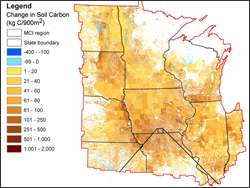Source: Sara Uttech, Soil Science Society of America, 608-268-4948, suttechsoils.org

- Changes in soil carbon occur with changes in land management. Scientists at Oak Ridge National Laboratory and The University of Tennessee investigated quantifying soil carbon changes over large regions. They integrated remote sensing products with a national carbon accounting framework in a project funded by the U.S. National Aeronautics and Space Administration, Office of Earth Science. Results of the study were published in the March issue of the Soil Science Society of America Journal and were also presented at the NASA Joint Workshop on Biodiversity, Terrestrial Ecology, and Related Applied Sciences in August 2006.
Tris West, project leader, stated, “The use of remote sensing products allows for the identification of soil and environmental attributes that are associated with each unique combination of planted crop and associated management inputs at the sub-county scale.” The 1992 National Land Cover Data, based on Landsat TM remote sensing data, was initially used in the carbon accounting framework. The use of these data allowed for estimated changes in soil carbon flux to be delineated at a 30-meter resolution across four land-use categories: row crops, small grains, pasture/hay, and fallow. The spatially-resolved results can also be used for comparison to other site specific measurements, such as measurements from eddy flux towers and atmospheric transport models, currently being developed under the multi-agency North American Carbon Program.
The study resulted in the integration of remote sensing with soil science and agricultural economics, which was used to predict future land use. The study is a proof-of-concept that illustrates the ability to model carbon dynamics associated with actual crop fields for entire regions or continents. The spatially-explicit carbon accounting framework is currently limited by the temporal and spatial extent of current remote sensing products. Future work includes the integration of land-use data sets based on MODIS and the Indian Remote Sensing satellite. Through the integration of inventory data and remote sensing data, the scientists expect to make enhanced land management data sets available to the scientific community in the near future.
Further information:
+ Soil Science Society of America press release [external link]
+ Abstract: Estimating Regional Changes in Soil Carbon with High Spatial Resolution PDF (2MB)






